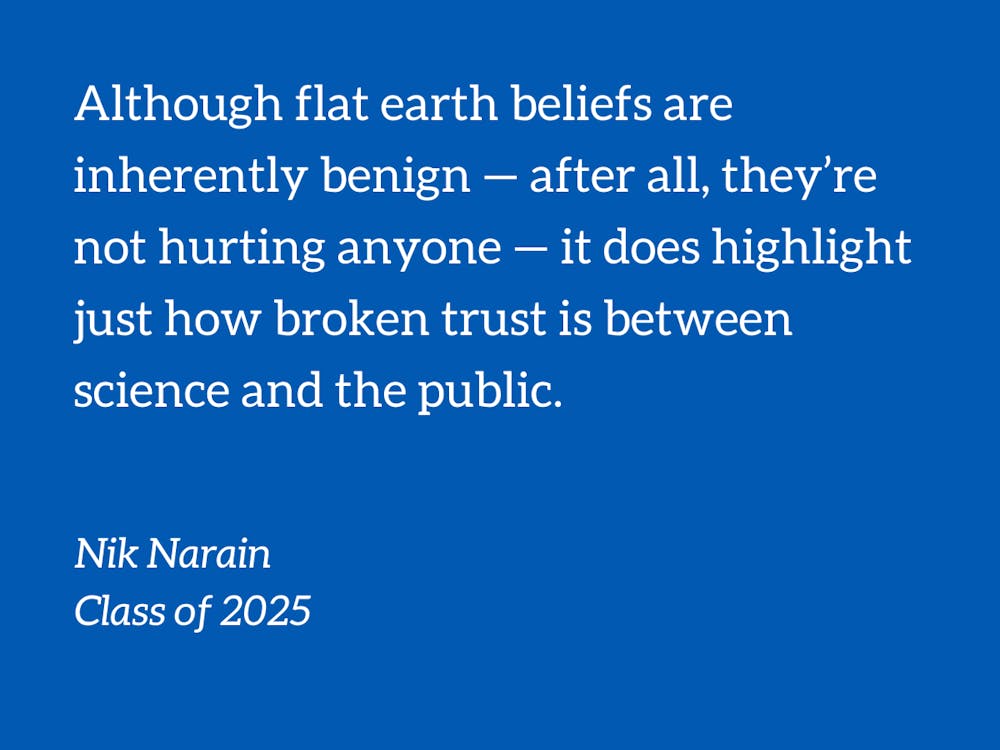In elementary school, one of my favorite pastimes was to memorize world capitals. I’d spin the globe in my first-grade teacher’s classroom and point to countries around the world to see if I remembered the differences between Budapest and Bucharest, Tokyo and Kyoto, Macedonia and Mauritania.
But, therein lies the problem: that I was spinning a globe. A spherical globe meant to model the “correct” shape of the earth. And why did I say — why was I taught to say — around the world? Why, from such a young age, was I indoctrinated into the ideology that claimed the Earth was round, rather than the true geomorphic tortilla (or tortilloid) on which civilization has flourished for centuries?
Earth’s spherical geometry has been settled since the third century B.C.E. by ancient Greek philosophers like Aristotle who obtained empirical evidence after traveling to Egypt and seeing new constellations of stars. Eratosthenes, in the third century BC, became the first person to calculate the circumference of the Earth, with further geometric calculations performed by Islamic scholars in later centuries. Images from space were final proof in the late 1940s.
The notion of flat earth can be traced to the 19th century English writer Samuel Rowbotham, who wrote under the name Parallax, which sounds kind of like a digestive medication. Rowbotham’s observations on a six-mile straight-line stretch of the Bedford River led him to believe the Earth was actually flat, and he spent the rest of his life investigating and arguing the case. In his 1865 book "Zetetic Astronomy: Earth Not a Globe," Rowbotham models the Earth as a flat disc centered at the North Pole with the Sun, Moon, planets, and stars moving only several thousand miles above the surface of the Earth.
Formed around his views, the Universal Zetetic Society waned in popularity during the world wars, and eventually made a resurgence as the International Flat Earth Society by Samuel Shenton in 1956 as a small group of fringe conspiracists. Following Shenton’s death in 1972, the International Flat Earth Society was taken over by Charles Kenneth Johnson, who was credited by Smithsonian magazine writer Danny Lewis to have transformed the group into an organization of thousands of members, at one point consisting of 3,500 people.
When the Internet took off in the 2000s, Flat Earth found a new platform on YouTube, which is where the majority of today’s Flat Earthers began their journey through channels and podcasts "debunking" claims of scientism and biblical literalism. Flat Earth subcultures have given rise to multiple theories of Earth’s geometries, from Rowbotham’s icy disk, to Earth being flat but encompassed in a Truman Show-esque snowglobe from which nothing can fall off the edges. Some Flat Earthers also reject gravity and distrust scientists and scientific institutions, especially NASA, who many believe to be part of a larger conspiracy of paid actors and falsified images. Many Flat Earthers often believe in other conspiracies too, like the moon landing being faked.
"If the Earth is round, how can I see skyscrapers in the distance?" "If I live in Australia, how come I’m not standing upside down?" "Why are all the close-up pictures of earth in space flat?" Online forums have made it possible for Flat Earthers to congregate in person for these discussions at international conferences since 2009; the one in 2018 was hosted right here in the Triangle. Flat Earth has even received multiple celebrity endorsements, such as NBA player Kyrie Irving (though he later apologized) and rapper B.o.B., who began a GoFundMe in 2017 to raise 200,000 to launch interstellar satellites to "find the curve."
It’s easy for most of us to laugh at such claims, but such derision is only part of the problem. According to Asheley Landrum, a psychologist at Texas Tech who studies scientific misinformation, Flat Earthers are "very sincere in their beliefs," and are not building these communities out of farce. She says that Flat Earthers aren’t necessarily people who don’t believe in science, and are often in support of the scientific method. "It’s not really an education thing…it really is about distrusting authorities and institutions."
On a 2021 nationwide survey, around 10 percent of respondents agreed with conspiracy claims that the Earth is flat and NASA faked the Moon landings. Although flat earth beliefs are inherently benign — after all, they’re not hurting anyone — it does highlight just how broken trust is between science and the public. Although science ideally is not an ideology by definition, we now no longer live in the world where we can take science as fact detached from politicization and/or media sensationalization. Flat Earth culture further highlights the power of algorithms for normalizing conspiratorial views and how we can cherry-pick and narrativize evidence to see the universe exactly how we want to. Finally, Flat Earth demonstrates the power of community in reinforcing one’s beliefs and how the feelings of belonging and camaraderie in a belief system can be as important as the beliefs themselves.
Bandwagons are the most convenient form of philosophical mobility. An echo chamber is much more mellifluous than a battleground of contradictory information. Fortunately and unfortunately, media-based solutions are almost always additive: we cannot take away flat earth content, but we can generate content demonstrating the evidence for a spherical earth and hope the algorithm™ catches on. We can also advocate for changes in algorithms on YouTube or Instagram to diversify its suggestions for future content. For now, I’d say it’s best if we stop laughing and start listening. It is near impossible to change someone's views instantaneously, but hate and ridicule won’t get anyone anywhere.
Nik Narain is a Trinity senior. His pieces typically run on alternate Saturdays.
Get The Chronicle straight to your inbox
Sign up for our weekly newsletter. Cancel at any time.

